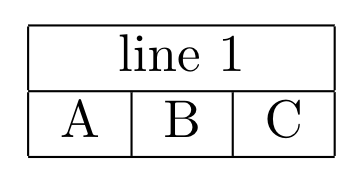\multicolumn を使って、結合する行の成分の数を指定することができる。
次の例では「3」を指定して、結合している。
例
\begin{table}
\begin{tabular}{ |c|c|c|c| }
\hline
\multicolumn{3}{|c|}{line 1} \\
\hline
A & B & C\\
\hline
\end{tabular}
\end{table}
結果

雑記
投稿日:
\multicolumn を使って、結合する行の成分の数を指定することができる。
次の例では「3」を指定して、結合している。
\begin{table}
\begin{tabular}{ |c|c|c|c| }
\hline
\multicolumn{3}{|c|}{line 1} \\
\hline
A & B & C\\
\hline
\end{tabular}
\end{table}

執筆者:seyanen
関連記事

分子・分母にシグマ記号(和記号)を使うと、小さくつぶれて見にくいことがある。対策として、\displaystyle を使う。 例 $\frac{\displaystyle \sum_{i=1}^{\i …

罫線を出力するには、pyplot.grid を使う。 例 import numpy as np import matplotlib.pyplot as plt x = np.linspace(0, 2 …

文章が、ある文字列で始まるかどうかを判定するには startswith を使う。 例 str = “こんにちは。” print(str.startswith(‘こん’)) print(str.star …

matplotlib で x, y軸・タイトルのフォントサイズを調整する
ラベルの fontsize で指定する。 例 import numpy as np import matplotlib.pyplot as plt x = np.linspace(0, 2, 100) …

2023/01/18
matplotlib のグラフ作成と gnuplot との対応 比較

2022/10/14
pythonで配列(リスト)の、ある要素がわかっているときにその次の要素を取得する方法。